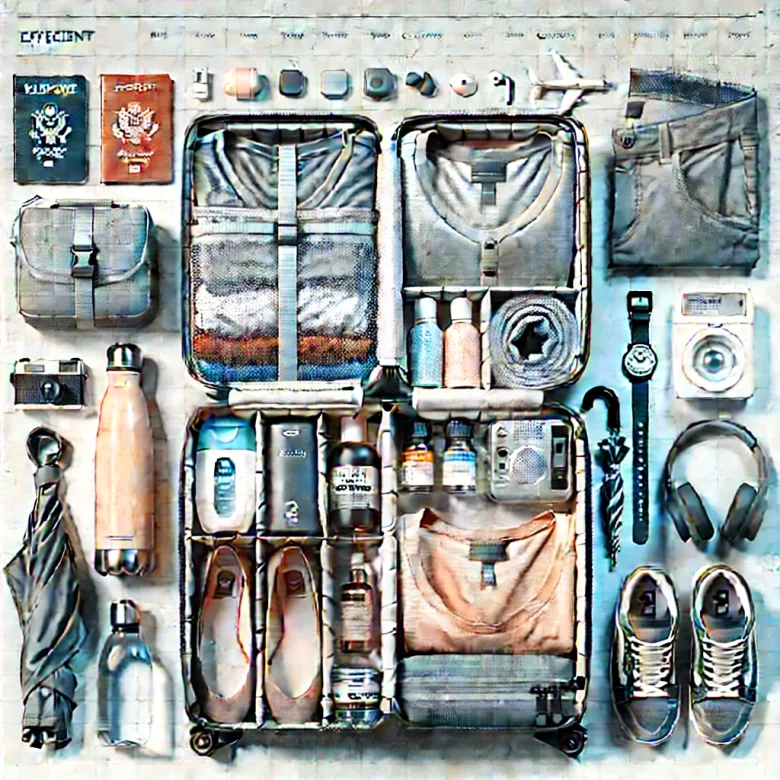Packing for a short trip can be a daunting task, especially when you want to travel light without sacrificing comfort or practicality. Whether it’s a weekend getaway, a business trip, or a short vacation, packing efficiently is crucial for a stress-free experience. The key to organizing your luggage for short trips is to focus on the essentials and prioritize versatility.
This article will provide you with practical tips on how to organize your luggage with minimal items, ensuring you have everything you need while keeping your bag light and easy to carry.
The Challenge of Packing Light
When preparing for a short trip, it’s easy to fall into the trap of overpacking. You might think you need to bring everything, just in case. However, carrying around a heavy, overstuffed suitcase can quickly turn your trip into a hassle. The goal is to find a balance between packing enough for your trip and keeping your luggage light and manageable.
By packing efficiently and sticking to only the essentials, you can enjoy a smoother, more enjoyable trip. In this article, we’ll walk you through a step-by-step process to help you organize your luggage for a short trip, while minimizing the number of items you carry.
Choose the Right Luggage
The first step in packing light is to choose the right luggage. The size and type of luggage you use will play a significant role in how efficiently you can pack. For short trips, a small carry-on suitcase or a travel backpack is usually sufficient.
Considerations for Selecting Your Luggage
- Carry-on Size: Opt for a small carry-on suitcase or duffel bag that meets airline regulations for hand luggage. This will save you time and money, as you won’t need to check in your bag.
- Versatility: Choose luggage with compartments or organizers to keep your items organized and easy to access.
- Durability: Select luggage that’s made from durable materials, as you’ll want your bag to withstand the rigors of travel.
When selecting luggage, remember that smaller and more compact options are always better for short trips, as they encourage you to pack minimally.
Create a Packing List
Creating a packing list is an essential part of organizing your luggage. Having a checklist ensures that you don’t forget anything important and helps you avoid overpacking.
How to Create an Efficient Packing List
- Make a List of Essentials: Write down the items you absolutely need for your trip. This should include clothing, toiletries, and any necessary documents or electronics.
- Think Versatility: Choose clothing items that can be mixed and matched easily. Stick to neutral colors and versatile pieces that can serve multiple purposes.
- Limit “Just-in-Case” Items: Be realistic about what you actually need. If you’re going to a place with predictable weather, avoid packing extra clothes “just in case.”
Example Packing List for a Weekend Trip
- Clothing: 2 pairs of pants, 3 shirts, 1 jacket, 1 set of pajamas, 1 pair of shoes, underwear, socks
- Toiletries: Travel-sized shampoo, toothpaste, toothbrush, deodorant, skincare essentials
- Electronics: Phone, charger, headphones, power bank
- Documents: ID, tickets, reservation confirmations
- Other Essentials: Sunglasses, wallet, travel pillow
By making a list of essentials, you’ll avoid packing unnecessary items and ensure that you’re prepared for your trip.
Choose the Right Clothing
When packing for short trips, your clothing choices are key to minimizing the number of items you bring. The goal is to pack versatile pieces that can be mixed and matched throughout your trip.
Tips for Packing Clothing for Short Trips
- Stick to Neutral Colors: Pack clothing in neutral tones that can be easily paired with other items. Black, white, gray, and navy are all great options that work well together.
- Layering is Key: Instead of packing bulky items, choose lightweight layers that can be added or removed depending on the weather.
- Opt for Quick-Drying Fabrics: If you’re traveling to a destination where you may need to wash clothes, opt for quick-drying fabrics that will be ready to wear the next day.
- Limit Shoes: Shoes take up a lot of space in your luggage, so pack no more than two pairs: one comfortable pair for walking and one pair for more formal or special occasions.
Example Clothing Capsule for a Weekend Trip
- 2 pairs of pants (1 casual, 1 slightly dressy)
- 3 shirts (2 casual, 1 nicer option for evening)
- 1 jacket or sweater
- 1 pair of shoes (comfortable, versatile)
- Undergarments and socks for the duration of the trip
By sticking to a small number of clothing items that are easy to mix and match, you can pack light without sacrificing style or comfort.
Optimize Your Toiletries
Toiletries can be one of the most difficult areas to minimize, especially if you’re used to bringing large bottles of products. However, there are many ways to reduce the number of toiletries you bring without compromising your personal care routine.
Tips for Packing Toiletries
- Use Travel-Sized Bottles: Invest in small, travel-sized containers for your liquids, such as shampoo, conditioner, and lotion. Alternatively, buy travel-sized versions of your favorite products.
- Multi-Use Products: Choose toiletries that serve multiple purposes. For example, a shampoo that also works as body wash can save you space and weight.
- Minimize Makeup: If you wear makeup, stick to the basics—foundation, mascara, and lip balm. Skip the extra products to keep your toiletries minimal.
- Toiletry Bag: Use a small, clear toiletry bag with compartments to organize your items and make them easy to access.
Essential Toiletries for a Short Trip
- Shampoo and conditioner (in travel-sized bottles)
- Toothbrush and toothpaste
- Deodorant
- Face wash and moisturizer
- Sunscreen (if needed)
- Any prescription medications or personal care items
By minimizing the number of toiletries and using multi-functional products, you can save valuable space in your luggage.
Use Packing Cubes and Organizers
One of the most effective ways to stay organized while packing minimally is to use packing cubes or organizers. These items help keep your luggage neat and allow you to fit more in a smaller space.
Benefits of Packing Cubes and Organizers
- Maximize Space: Packing cubes compress your clothing, helping you fit more into your luggage while keeping everything organized.
- Easy Access: With packing cubes, you can easily access the items you need without having to dig through your entire bag.
- Keep Items Organized: Use different packing cubes for different categories of items, such as clothing, shoes, and toiletries, so you can quickly locate what you need.
How to Use Packing Cubes Effectively
- Roll Your Clothes: Rolling your clothes instead of folding them helps save space and reduces wrinkles.
- Group Similar Items Together: Pack your clothes by type—pants in one cube, shirts in another, and shoes in a separate compartment.
- Use Compression: Some packing cubes offer compression zippers that can help you further reduce the amount of space your items take up.
Using packing cubes and organizers will help you stay organized, even with a limited amount of items.
Plan for Travel Accessories
In addition to your clothing, toiletries, and electronics, it’s important to consider the smaller travel accessories that can make your trip easier and more enjoyable. These accessories don’t have to take up much space, but they can serve a crucial role in organizing your items and ensuring that you have everything you need without overpacking.
Essential Travel Accessories to Pack
- Travel Pillow: If you’re flying or taking a long drive, a travel pillow can make a big difference in your comfort. Look for an inflatable or memory foam pillow that can easily be packed and doesn’t take up much space.
- Portable Water Bottle: Stay hydrated while traveling by bringing a compact, reusable water bottle. Many airports and public places now offer water refill stations, so a bottle will help you save money and reduce waste.
- Compact Umbrella: Packing a small, foldable umbrella is a smart way to stay prepared for unexpected weather. Choose one that’s lightweight and easy to store in your bag.
- Headphones or Earplugs: Whether you’re on a plane, train, or in a noisy hotel, a good pair of noise-canceling headphones or earplugs can help you stay relaxed and enjoy your surroundings without distractions.
By packing these small but valuable accessories, you’ll be able to maintain comfort and convenience throughout your trip without adding bulk to your luggage.
Avoid Overpacking “Just in Case” Items
One of the most common mistakes travelers make when packing for a short trip is including “just in case” items. These are things you think you might need but probably won’t. While it’s natural to want to be prepared for any scenario, the reality is that overpacking these items will only weigh you down and fill your bag with unnecessary clutter.
How to Avoid Overpacking
- Don’t Pack for Every Possible Scenario: Think about your destination and activities. Are you really going to need a formal outfit for a casual weekend getaway? Are you likely to need five pairs of shoes? Be realistic about the type of trip you’re taking and pack accordingly.
- Borrow or Buy Items Locally: If you find you need something during your trip that you didn’t pack, consider buying it locally or borrowing it from a friend or hotel. This way, you don’t waste space on items you won’t use.
- Reassess Your Packing List: Once you’ve packed your bag, go through it again and ask yourself, “Will I really need this?” If the answer is no, leave it behind.
By eliminating “just in case” items from your packing list, you’ll create more space for what truly matters and reduce the overall weight of your luggage.
Stay Flexible and Adapt to Your Destination
Finally, it’s important to stay flexible and adapt your packing strategy based on your destination and the length of your trip. Packing light is a personal experience, and what works for one person may not work for another.
Adapting to Your Destination
- Consider the Climate: If you’re going to a warm destination, pack lightweight, breathable fabrics. If you’re heading to a colder location, make sure to pack layers that you can add or remove as needed.
- Research the Local Culture: Some destinations have specific clothing requirements or cultural norms. For instance, certain places may require modest clothing when visiting religious sites, while others may have very casual dress codes.
- Plan for Activities: If your trip includes activities like hiking, swimming, or formal events, make sure you pack the necessary items to stay comfortable and prepared. Choose versatile clothing that can transition from one activity to another.
By adjusting your packing list to your destination, you ensure that you’re fully prepared without overpacking unnecessary items.
Packing Light is the Key to Stress-Free Travel
Packing for a short trip with minimal items doesn’t mean you have to sacrifice comfort, style, or convenience. By following these practical tips—choosing the right luggage, organizing your clothing, optimizing your toiletries, and including essential accessories—you can ensure that your luggage is light, organized, and easy to manage.
The key is to pack with intention, focusing on versatility and what you truly need for your trip. Remember that the goal is not to bring everything, but to bring only what will enhance your experience and make your travel more enjoyable. By staying flexible, avoiding overpacking, and organizing your luggage efficiently, you’ll be able to travel smarter and enjoy your trip without the burden of excess baggage.
With the right mindset and preparation, you’ll be able to enjoy a stress-free, well-organized trip with minimal luggage and maximum comfort. Safe travels!




